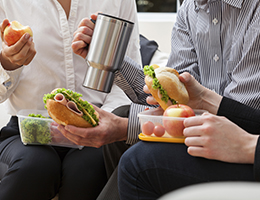
We munch, crunch and often do lunch. Most of us spend at least a little time eating on the job. But while you might not think of food poisoning as a workplace hazard, it can be.
That's true whether you brown bag it, hit the drive-thru and then eat at your desk, or help yourself to snacks in the office fridge. However, you can take steps to give disease-causing bacteria the pink slip.
Here are four workplace food safety threats—and ways to protect yourself, advised by the Academy of Nutrition and Dietetics and other experts.
1. Food that isn't cool. The bacteria that cause many foodborne illnesses thrive in temperatures between 40 and 140 degrees—what's aptly called the danger zone. To help keep bacteria from multiplying, it's important to keep perishable foods—like meat sandwiches, leftovers, salads or dairy products—below 40 degrees.
To stay safe:
- Keep an eye on the time. If you pack perishable food, don't let more than two hours pass from the time you make your lunch at home until you put it in the office fridge. If there's no fridge at work, pack your lunch in an insulated bag with a freezer pack or a frozen bottle of water.
At office potlucks, watch the clock too. Discard any perishable food that's been sitting out at room at room temperature longer than two hours.
- Don't let leftovers linger. Refrigerate perishable foods as soon as you're done eating. Don't keep them at your desk.
- Get a reading. Place a thermometer in the office fridge and check it periodically to make sure it stays below 40 degrees.
2. Food that's outlived its shelf life. You can't tell if a food is contaminated with disease-causing germs by how it looks or smells. And it doesn't take long for food to go bad.
To stay safe:
- Know when to toss. As a general rule, don't keep refrigerated leftovers for more than four days. But when it doubt, toss food out.
- Give yourself a reminder. When you put leftovers in the office fridge, label them with the date. That makes it easier to know when it's time to pitch something out.
3. Dirty hands. Throughout your workday, you touch things that contain germs—your phone, your keyboard and even other people's hands. Those germs can spread to food or your mouth when you eat.
To stay safe:
- Scrub away germs. Always wash your hands—the right way—before eating. Scrub your hands in running water for at least 20 seconds.
- Be prepared. Keep sanitizer at your desk. It's the next best thing when soap and water aren't handy.
4. Germ-covered surfaces. Refrigerators, microwaves and countertops can all become breeding grounds for germs.
To stay safe:
- Clean up spills and messes right away. Use a clean sponge with warm soapy water.
- Prevent microwave splatter. Cover food when reheating it.
- Don't forget to clean your lunchbox. If you use one (or a lunch tote), wash it frequently.
Reviewed 5/22/2023